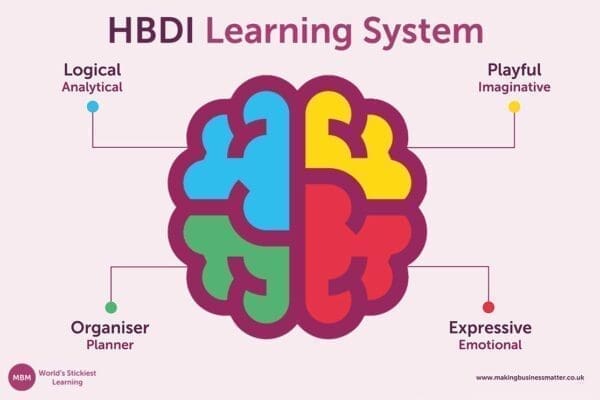The Different Thinkers
We think he looks like Captain Birds Eye. The old one, not the new trendy one. Ned Herrmann (Mr Old Birds Eye) created a psychometric test in the ’60s. A little like the Myers-Briggs test, but easier to remember (Can you remember your 4 letters? It starts with an E and then…?). Mr Herrmann realised that people thought differently and spent the next 40 years creating a way of understanding our thinking preference. The H.B.D.I. – Herrmann Brain Dominance Instrument. Why should you care? Only if you present.
Four Ways of Thinking
Most people struggle to present in an engaging way. They present in their language. Ned found that people have a preference for one of four ways to think:
- Facts: Ever been to a pub quiz and your mate knows all the answers?
- Form: Structure is important to these people. Those that get excited by a plan.
- Feelings: You walk into a room, and they are the first to say hello, and may touch your elbow.
- Future: The visionaries. They can be described as ‘head in the clouds daydreamers’. Lots of ideas.

You have a preference for one of these above. And this is how you present. You built the presentation to answer the questions from your perspective. Your language. The downside? If these are 4 different languages, then you are speaking Dutch to the other 25% of Dutch people in the room. The other 75% switched-off because they speak German, Italian and French.
Presenting to the Masses
How do you engage them all? Present to them all. Go beyond just what you need, what your language wants, and give them what they all want. Hard? Yep. But, what’s the alternative? Present to a quarter of the room only? Here’s how:
- Facts: Include the facts of your presentation. Include the numbers and take the numbers to 1 decimal place, where relevant. E.g. According to the research from xyz shopper research, 92.1% of all shoppers prefer…’.
- Form: Include the plan for how to achieve your recommendations, with weeks/months and show this as a plan.
- Feelings: Include how the people will feel. Add some emotion. E.g. ‘To close the £10m gap would be awesome! And then we can celebrate together’.
- Future: In 1-year the effects of extending the range will be that the frequency of purchase is forecasted to increase from 1.3 to 2.1.
Appeal to all four thinking preferences and you will engage your whole audience. Plus, the Captain would be proud!
This article was written by Darren A. Smith for The Grocer.
Action: For even more useful content, check out our ultimate guide on presentation skills and HBDI.




